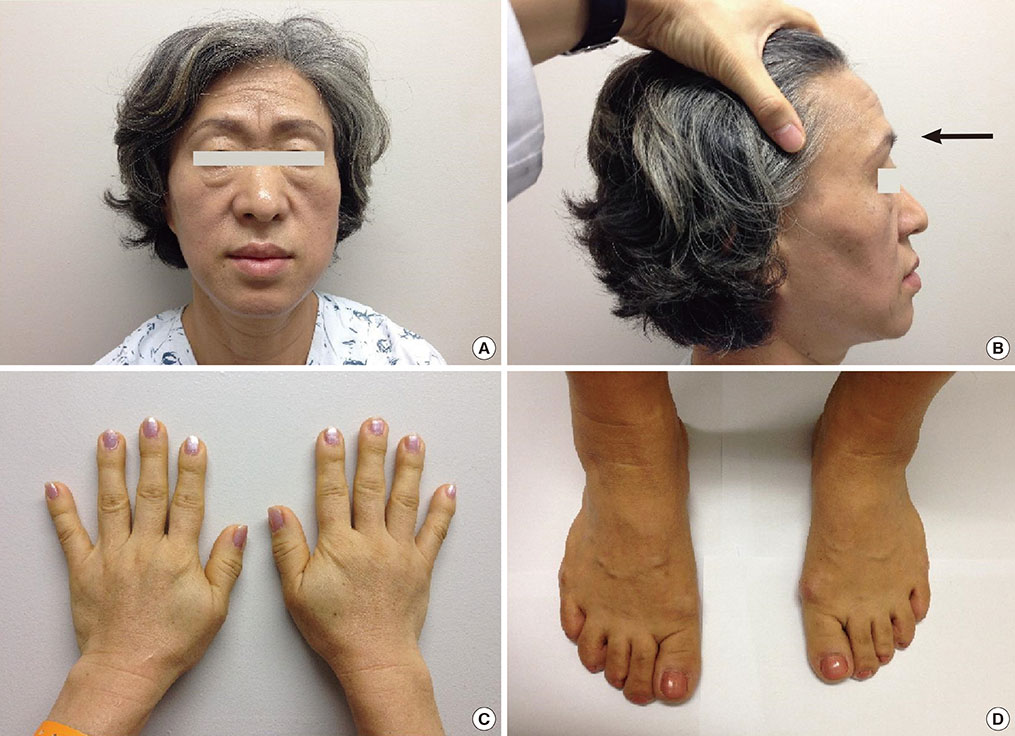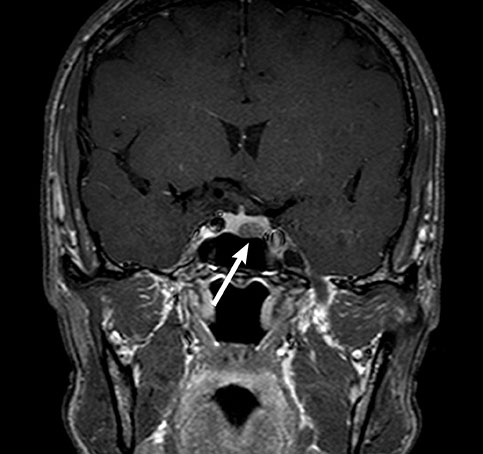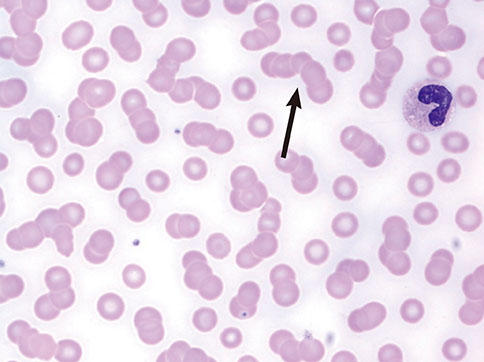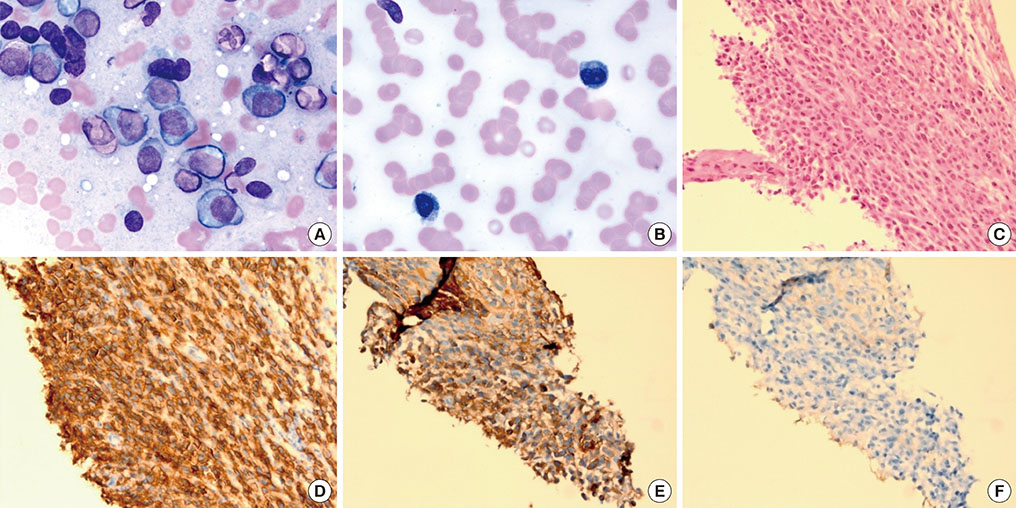Endocrinol Metab.
2015 Mar;30(1):110-115. 10.3803/EnM.2015.30.1.110.
Multiple Myeloma in a Patient with Acromegaly
- Affiliations
-
- 1Division of Endocrinology and Metabolism, Department of Internal Medicine, Asan Medical Center, University of Ulsan College of Medicine, Seoul, Korea. mskim@amc.seoul.kr
- 2Department of Laboratory Medicine, Asan Medical Center, University of Ulsan College of Medicine, Seoul, Korea.
- 3Department of Internal Medicine, Asan Medical Center, University of Ulsan College of Medicine, Seoul, Korea.
- KMID: 2407113
- DOI: http://doi.org/10.3803/EnM.2015.30.1.110
Abstract
- Acromegaly is a slowly progressing condition resulting from excess growth hormone (GH), generally caused by a GH-secreting pituitary adenoma. Cancer is the third most common cause of mortality in patients with acromegaly, and insulin-like growth factor 1 (IGF-1) is known to influence tumor formation by increasing cell proliferation and inhibiting apoptosis. Multiple myeloma (MM) is a plasma cell neoplasm, and previous studies have suggested the possible role of IGF-1 in its development of MM. However, no cases of acromegaly accompanied with MM have been reported in Asia to date. We here report the case of a 58-year-old woman with acromegaly accompanied with MM who presented with longstanding acromegalic manifestations resulting from a GH-secreting pituitary adenoma and also exhibited anemia, a reversed albumin/globulin ratio, and plasmacytosis on bone marrow examination. Because IGF-1 has been suggested to play an important role in the development and progression of MM, the patient promptly underwent surgical removal of the pituitary adenoma via a transsphenoidal approach. Since there is currently no consensus on therapeutic guidelines and suggested prognosis for MM with acromegaly, long-term follow-up of such cases is needed.
MeSH Terms
-
Acromegaly*
Anemia
Apoptosis
Asia
Bone Marrow Examination
Cell Proliferation
Consensus
Female
Growth Hormone
Growth Hormone-Secreting Pituitary Adenoma
Humans
Insulin-Like Growth Factor I
Middle Aged
Mortality
Multiple Myeloma*
Neoplasms, Plasma Cell
Pituitary Neoplasms
Prognosis
Growth Hormone
Insulin-Like Growth Factor I
Figure
Reference
-
1. Nabarro JD. Acromegaly. Clin Endocrinol (Oxf). 1987; 26:481–512.2. Freda PU, Post KD. Differential diagnosis of sellar masses. Endocrinol Metab Clin North Am. 1999; 28:81–117.3. Orme SM, McNally RJ, Cartwright RA, Belchetz PE. Mortality and cancer incidence in acromegaly: a retrospective cohort study. United Kingdom Acromegaly Study Group. J Clin Endocrinol Metab. 1998; 83:2730–2734.4. Melmed S. Acromegaly and cancer: not a problem? J Clin Endocrinol Metab. 2001; 86:2929–2934.5. Hankinson SE, Willett WC, Colditz GA, Hunter DJ, Michaud DS, Deroo B, Rosner B, Speizer FE, Pollak M. Circulating concentrations of insulin-like growth factor-I and risk of breast cancer. Lancet. 1998; 351:1393–1396.6. Ma J, Pollak MN, Giovannucci E, Chan JM, Tao Y, Hennekens CH, Stampfer MJ. Prospective study of colorectal cancer risk in men and plasma levels of insulin-like growth factor (IGF)-I and IGF-binding protein-3. J Natl Cancer Inst. 1999; 91:620–625.7. Riedel DA, Pottern LM. The epidemiology of multiple myeloma. Hematol Oncol Clin North Am. 1992; 6:225–247.8. Murphy WJ, Rui H, Longo DL. Effects of growth hormone and prolactin immune development and function. Life Sci. 1995; 57:1–14.9. Georgii-Hemming P, Wiklund HJ, Ljunggren O, Nilsson K. Insulin-like growth factor I is a growth and survival factor in human multiple myeloma cell lines. Blood. 1996; 88:2250–2258.10. Kanazawa I, Yamaguchi T, Yamane Y, Murakami N, Kato Y, Sugimoto T. Acromegaly associated with monoclonal gammopathy of undetermined significance (MGUS). Endocr J. 2006; 53:687–691.11. Tucci A, Bonadonna S, Cattaneo C, Ungari M, Giustina A, Guiseppe R. Transformation of a MGUS to overt multiple myeloma: the possible role of a pituitary macroadenoma secreting high levels of insulin-like growth factor 1 (IGF-1). Leuk Lymphoma. 2003; 44:543–545.12. Barbosa FR, Vieira Neto L, Lima GA, Wildemberg LE, Portugal R, Gadelha MR. Hematologic neoplasias and acromegaly. Pituitary. 2011; 14:377–381.13. Hagg E, Asplund K, Holm J. Acromegaly and multiple myeloma. Ann Intern Med. 1988; 109:437–438.14. Ge NL, Rudikoff S. Insulin-like growth factor I is a dual effector of multiple myeloma cell growth. Blood. 2000; 96:2856–2861.
- Full Text Links
- Actions
-
Cited
- CITED
-
- Close
- Share
- Similar articles
-
- Multiple myeloma
- Nonsecretory Multiple Myeloma associated with Immune Thrombocytopenia and Complicated by Malignant Ascites
- Acute Pancreatitis with Hypercalcemia as Initial Manifestation of Multiple Myeloma
- Continuous Multiple Vertebral Compression Fractures in Multiple Myeloma Patient
- Hereditary Aspect of Isolated Familial Acromegaly





